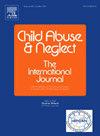儿童性引诱:倾听约旦的受害者。
IF 3.4
2区 心理学
Q1 FAMILY STUDIES
引用次数: 0
摘要
背景:人们对阿拉伯-伊斯兰国家儿童的性教育知之甚少。在这种情况下接触儿童性虐待受害者是具有挑战性的;然而,定性的二次分析为探索这一现象提供了一个框架。目的:本研究采用定性二次分析方法,基于约旦儿童的性梳理行为和策略。参与者和背景:主要数据集包括13份针对6-18岁具有阿拉伯伊斯兰背景的儿童受害者的法医调查陈述的逐字抄本。这些声明是从约旦安曼家庭保护部获得的。方法:将这些陈述从阿拉伯语翻译成英语,并以Winters、Jeglic和Kaylor开发的2020 Sexual Grooming Model为框架,进行独立的归纳主题分析和演绎分析。结果:使用该模型确定了儿童性修饰的四个阶段,每个阶段都有特定的目标和策略。然而,研究结果和模型之间存在具体的细微差异,突出了阿拉伯文化和伊斯兰宗教对约旦打扮的影响。结论:应作出教育努力,提高父母和儿童对梳洗策略的认识,特别是如何利用阿拉伯文化和伊斯兰原则来强迫儿童遵守梳洗和虐待,或以其他方式迫使他们因害怕惩罚而保持沉默。本文章由计算机程序翻译,如有差异,请以英文原文为准。
Child sexual grooming: Listening to victims in Jordan
Background
Little is known about sexual grooming among children in Arab-Islamic countries. Accessing victims of child sexual abuse in such a context is challenging; however, qualitative secondary analysis provides a framework for exploring this phenomenon.
Objective
This study employed qualitative secondary analysis to identify sexual grooming behavior and strategies based on the statements made by Jordanian children.
Participants and setting
The primary dataset comprised 13 verbatim transcripts of forensic investigative statements of child victims aged 6–18 years with an Arabic Islamic background. These statements were obtained from the Family Protection Department of Amman, Jordan.
Methods
The statements were translated from Arabic to English and subjected to independent inductive thematic analysis and deductive analysis using the 2020 Sexual Grooming Model developed by Winters, Jeglic, and Kaylor as a framework.
Results
Four stages of child sexual grooming, each with specific goals and strategies, were identified and contextualized using the model. However, specific, nuanced differences between the findings and the model were identified, highlighting the influence of Arab culture and Islamic religious interpretations on grooming in Jordan.
Conclusions
Educational efforts should be undertaken to raise awareness among parents and children regarding grooming strategies and, specifically, how Arab culture and Islamic principles may be used to coerce children to comply with grooming and abuse or otherwise compel their silence out of fear of punishment.
求助全文
通过发布文献求助,成功后即可免费获取论文全文。
去求助
来源期刊

Child Abuse & Neglect
Multiple-
CiteScore
7.40
自引率
10.40%
发文量
397
期刊介绍:
Official Publication of the International Society for Prevention of Child Abuse and Neglect. Child Abuse & Neglect The International Journal, provides an international, multidisciplinary forum on all aspects of child abuse and neglect, with special emphasis on prevention and treatment; the scope extends further to all those aspects of life which either favor or hinder child development. While contributions will primarily be from the fields of psychology, psychiatry, social work, medicine, nursing, law enforcement, legislature, education, and anthropology, the Journal encourages the concerned lay individual and child-oriented advocate organizations to contribute.
 求助内容:
求助内容: 应助结果提醒方式:
应助结果提醒方式:


